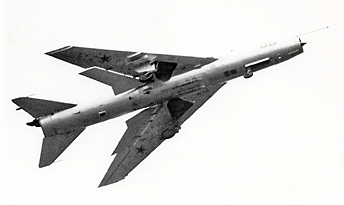
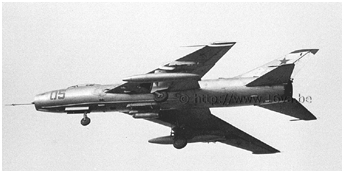 During the first half of the seventies a special tactic to destroy the NATO Hawk surface-to-air missile batteries was revealed to the
West. Su-7 fighter-bomber units had been trained to open penetration corridors through the Hawk missiles belt defence by the means of
tactical nuclear weapons. In order to protect the raid in which the
aircraft carrying the nuclear weapon was included, a conventional attack would have taken place immediately before the
nuclear attack itself, in order to disrupt the enemy defences. The Hawk missiles could engage targets flying at low and medium level.
They were considered by the Soviets as targets of category 1 with the highest priority.
A nuclear attack would have taken place in three different phases. The first phase would have been the flight to the target.
The attacking aircraft were divided in three groups of a minimum of two aircraft (1),
each group flying in line abreast. A Hawk unit or batallion comprised four batteries (sites) (2).
Three of them were immediately active - during crisis or wartime. They formed a triangle of which the base
was - rather symbolically as it was not an operational requirement - facing to the East. The third battery at the rear should
intercept aircraft breaking through the defence line. The fourth site was kept in reserve in case of destruction or technical
problems at another site. Each site or battery was composed of two sections of three triple missile launchers. Three different
detection radars (PAR, CWAR and ROR - one of each) were available on a site for the two firing sections. Each section had its
own HPIR tracking radar (see schema > here). The latter could only track one target at a time
("One lock, one kill"). Two enemy aircraft
approaching (or two groups of aircraft: the Hawk missile had a lethal radius of destruction of 180 metres (600 feet) - it is however highly unlikely
that the Soviets would have made the mistake of attacking in tight formation) were enough to saturate temporarily a battery.
During the first half of the seventies a special tactic to destroy the NATO Hawk surface-to-air missile batteries was revealed to the
West. Su-7 fighter-bomber units had been trained to open penetration corridors through the Hawk missiles belt defence by the means of
tactical nuclear weapons. In order to protect the raid in which the
aircraft carrying the nuclear weapon was included, a conventional attack would have taken place immediately before the
nuclear attack itself, in order to disrupt the enemy defences. The Hawk missiles could engage targets flying at low and medium level.
They were considered by the Soviets as targets of category 1 with the highest priority.
A nuclear attack would have taken place in three different phases. The first phase would have been the flight to the target.
The attacking aircraft were divided in three groups of a minimum of two aircraft (1),
each group flying in line abreast. A Hawk unit or batallion comprised four batteries (sites) (2).
Three of them were immediately active - during crisis or wartime. They formed a triangle of which the base
was - rather symbolically as it was not an operational requirement - facing to the East. The third battery at the rear should
intercept aircraft breaking through the defence line. The fourth site was kept in reserve in case of destruction or technical
problems at another site. Each site or battery was composed of two sections of three triple missile launchers. Three different
detection radars (PAR, CWAR and ROR - one of each) were available on a site for the two firing sections. Each section had its
own HPIR tracking radar (see schema > here). The latter could only track one target at a time
("One lock, one kill"). Two enemy aircraft
approaching (or two groups of aircraft: the Hawk missile had a lethal radius of destruction of 180 metres (600 feet) - it is however highly unlikely
that the Soviets would have made the mistake of attacking in tight formation) were enough to saturate temporarily a battery.
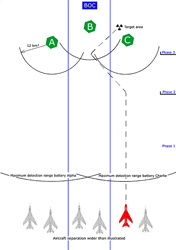
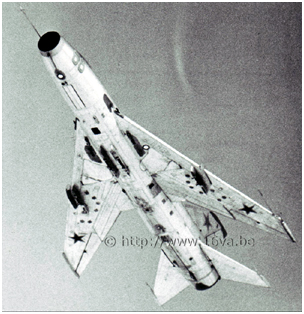 The Hawk sites were positioned in such a way that each one covered also partially the same area as their neighbouring sites. Their radar
beams overlapped each other. Consequently, the parts of the firing zones that were common to several batteries
could be saturated with missiles and the sites protected each other.
The approaching aircraft would have been detected by the Hawk system radars CWAR and PAR and the
radar of the BOC (Battalion Operations Centre) which was situated in a central position
(3). Each Hawk site would have been
attacked by a group of aircraft flying in loose formation. Consequently, the three operational Hawk sites (Alpha, Bravo, Charlie)
would have been saturated because each one would have had to deal with a group of aggressors.
The second phase of the attack was a deception manoeuvre. The aircraft loaded with a nuclear weapon, which was flying in one of
the external groups (in direction of battery "Charlie" - see schema at right) would turn towards the Hawk 'Bravo' central position
immediately before reaching the firing zone of the missiles from "Charlie" battery.
Normally, the central "Bravo" battery had been assigned the central group of attacking aircraft. The aircraft carrying
the nuclear weapon couldn’t therefore have been engaged by battery "Bravo". Also, it remained to some extent outside the firing zone of
the external Hawk site (battery "Charlie") that was
following it initially, entering at the same time inside the firing zone of the central battery that could not engage it.
It was then possible, for a brief moment to drop a nuclear bomb.
The Hawk sites were positioned in such a way that each one covered also partially the same area as their neighbouring sites. Their radar
beams overlapped each other. Consequently, the parts of the firing zones that were common to several batteries
could be saturated with missiles and the sites protected each other.
The approaching aircraft would have been detected by the Hawk system radars CWAR and PAR and the
radar of the BOC (Battalion Operations Centre) which was situated in a central position
(3). Each Hawk site would have been
attacked by a group of aircraft flying in loose formation. Consequently, the three operational Hawk sites (Alpha, Bravo, Charlie)
would have been saturated because each one would have had to deal with a group of aggressors.
The second phase of the attack was a deception manoeuvre. The aircraft loaded with a nuclear weapon, which was flying in one of
the external groups (in direction of battery "Charlie" - see schema at right) would turn towards the Hawk 'Bravo' central position
immediately before reaching the firing zone of the missiles from "Charlie" battery.
Normally, the central "Bravo" battery had been assigned the central group of attacking aircraft. The aircraft carrying
the nuclear weapon couldn’t therefore have been engaged by battery "Bravo". Also, it remained to some extent outside the firing zone of
the external Hawk site (battery "Charlie") that was
following it initially, entering at the same time inside the firing zone of the central battery that could not engage it.
It was then possible, for a brief moment to drop a nuclear bomb.
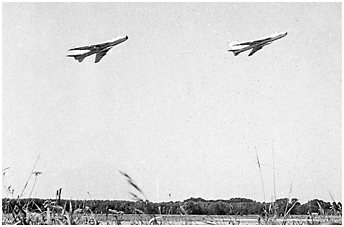 Décollage d'une para de Su-7BM du 19.GvIBAP à Lärz en 1976. © S.Popov.
Décollage d'une para de Su-7BM du 19.GvIBAP à Lärz en 1976. © S.Popov.
A Su-7BM para of the 19.GvIBAP taking off from Lärz in 1976. © S.Popov.
During the third phase of the attack, the nuclear armed aircraft would brutally reverse its track back to its original external
position, keeping the batteries saturated.
This tactic with abrupt turns just before reaching the lethal firing zone of the Hawk would have been executed at a height
between 50 and 100 meters. It exploited the weakness of the Hawk system: as mentioned earlier, a battery could only treat
two targets at the same time. Around 30 seconds were necessary to engage a target and fire a missile. The timing of the
attack with six aircraft had therefore to be sharp. If one aircraft had been shot down too early, the attack could quickly
turn into disaster - unless the nuclear aircraft survived. More aircraft would have been needed. That is the reason why
a first conventional strike was privileged right before the nuclear strike. In such a case, the second attack that included
the nuclear armed aircraft would have been confronted with batteries unable to shoot again with their full potential.
The course alteration of the nuclear armed aircraft towards the central site could not have gone unnoticed by the BOC,
but it would have created confusion and lead to hesitations in taking decisions as the central site was already engaging the central group
of attacking aircraft. Still under the psychological stress of a preceding conventional attack, the officers in charge would
have had difficulties to evaluate the situation and to reassign priority targets.
notes
(1)
A group of two aircraft was really the bare minimum. It
could be considered only after a conventional attack that would have seriously affected the Hawk batteries readiness not necessarily
by destroying them, but by forcing them to fire missiles that could not be replaced in time if the nuclear raid
followed shortly after. But even in these conditions, two aircraft would not have been enough to ensure a guaranteed success.
(2)
In case of war or serious crisis, the Hawk batteries would have moved to new locations - their positions were supposed to be
known by the enemy - in turns, every 24 hours. One would be on the move while the three other would temporarily remain
operational on site. It was then possible for a few hours, to attack only three batteries.
G.Dessornes, a former radar technician in a French Hawk battery says: 'From 1964-65 on, the French Hawk batteries were constantly
conducting redeployment exercises. For example, the units based around Munich on 'fixed' sites, had their redeployment plan
to secret sites 'in their pocket'. We were ready to move within the hour. Materiel and particularly the trucks were hard pressed
during those constant and temporary moves, which lasted only a few hours. We knew that the monitoring by the enemy was efficient.'
It was also possible to move a battery in two times in order to keep a limited firing capacity during the move.
The CWAR, PCP and one HPIR (see > The Hawk batteries) and three launchers left the site in first place.
When this advanced element called AFU (Assault Fire Unit) was operational on its new position, the second part of the battery
(PAR, ICC, ROR, BCC, second HPIR and last 3 launchers) left to rejoin the new position. However, those 'half-batteries'
were not very efficient and the time to move the complete battery was much longer. That procedure was interesting only when
one or several of the four batteries were not operational for technical reasons. The CRC or the BOC decided how to move the
batteries according to the situation.
We ignore if the decision to move the batteries was a consequence of the revelations made by Warsaw Pact defectors in the
early seventies or if it was already the normal procedure in case of crisis before.
The material was not always reliable and a battery or firing section temporarily
down was not a rare occurrence.
When the improved Hawk entered service progressively later during the seventies, some Hawk battalions were reduced to three sites.
(3)
During the seventies, the BOC's possessed an AN/TPS radar that was less efficient than the batteries’ radars. That radar - often defective -
revealed the BOC position to the enemy and it was sometimes removed. That depended however of the country. Some NATO members
upgraded their radars, like the USA.
Orders to track and shoot a target were sent to the batteries by the BOC.
The latter received its orders from the CRC (Command and Reporting Centre), which coordinated the action of the fighters and
the ground defences. The CRC received data from ground radars, fighters and AWACS.
A rather unreliable datalink was later introduced between the CRC and the BOC, which permitted to see the global situation on
a console in the BOC itself.
In some cases, the batteries could work 'Decentralized'. They had then the initiative and sent back the information to the BOC,
which relayed them to the CRC.
This chapter is an expanded adaptation of a text included in the article entitled 'Sowjetische Atombomben
in Europa - Ein Kapitel aus dem Kalten Krieg' by Stefan Büttner, published in the September 2008 issue of Fliegerrevue
Extra 22 (See Multimedia section).
 |
Hawk strike > Part 2 |
 |
Plan du site - Sitemap |  |
